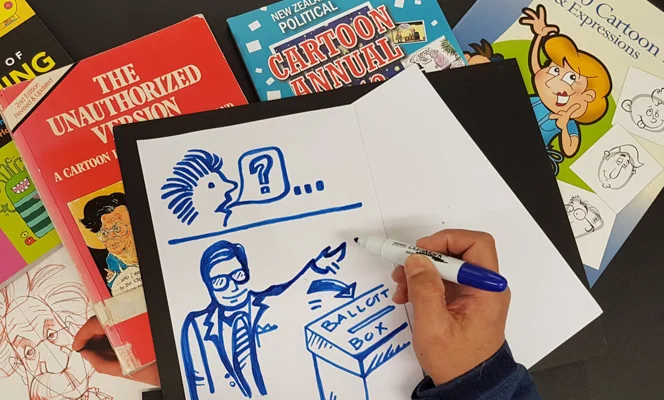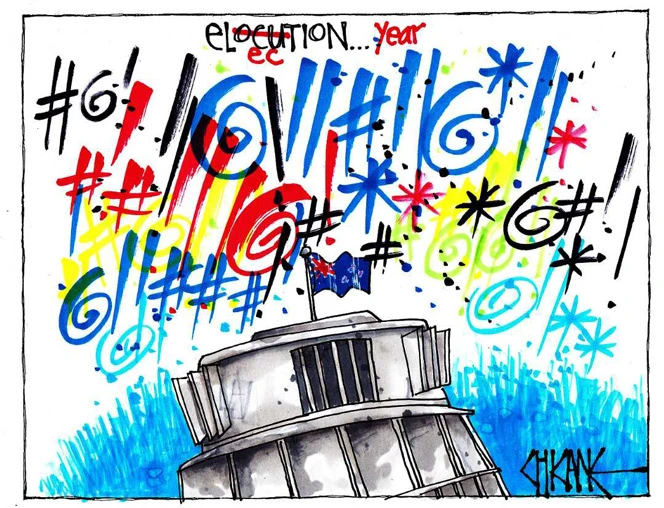Cartoons in the classroom
Cartoonists have a unique visual way of commenting on our contemporary world. A great cartoon is truly worth a thousand words. In fact, exploring how cartoons 'work' has relevance across the arts, social sciences, media studies, English and even history learning areas.
Cartoonists and the General Elections
Politically inspired cartoons are well-known for satirising famous people, especially politicians! Major political issues of the day have always been a fertile domain for cartoonists to explore. In fact, it could be said that cartoonists are the political conscience of our society.
With the 2017 General Election just around the corner, newspapers and magazines are full of politically inspired cartoons. Don't miss this opportunity to combine an appreciation of cartoons and how they can be used to stimulate discussions around political parties and personalities.
The cartoonist, given that special licence granted over the centuries, can say things others only dare whisper.
— David English, editor of Britain’s Daily Mail, in Quiplash 9, 2002.

Cartoons are a great classroom resource during General Elections.
Types of cartoons
Here are some types of cartoons you will find in newspapers, magazines or greeting cards:
Editorial or political cartoons are popular cartoons, usually with a humorous visual interpretation of a specific current event, but not always. They may depict an important contemporary figure or comment on a social, economic or political issue.
Comic strips are a short series of frames in a sequence. The last frame usually contains a 'punch line'.
Gag cartoons and panel cartoons often have an 'everyday' scenario with a punch line. Found on greeting cards or in magazines, their aim is to make people laugh.
Understanding cartoons
To get the best out of cartoons, it is important to understand both the subject of the cartoon and the visual language the cartoonist uses to persuade viewers to laugh or reflect on an issue. For example, cartoonists often use a form of art called 'caricature' where the features of a person, an object or situations are exaggerated for comic effect.
The Eastern Illinois University and the Library of Congress provide guidelines to analyse cartoons. Visual language techniques explored include the use of symbolism, exaggeration, labelling, analogy and irony.
VCE Study Guides provides an insightful analysis through the blog post 10 things to look out for in cartoons.
Teaching History has a cartoon analysis checklist (pdf, 105KB), which also looks at the difference between stereotypes and caricature, slogans and arguments.
Understanding the visual language and structure of comics is part of cartoon analysis. Lexicon of Comicana by Mort Walker is a highly recommended book in this area, as is the following article 10 words from the Lexicon of Comicana.

Orwell retitles '1984' as '2017', Mark Winter, 2017. Ref: DCDL-0035720
Finding great cartoons
The links below will help you explore the best cartoonists' works published in New Zealand and overseas.
New Zealand Cartoon Archive — This archive has an impressive collection of New Zealand cartoons and caricatures reflecting New Zealand culture and politics from the past to present. There is also a research guide to understand more about the archive. The Guardians of the New Zealand Cartoon Archive maintain an affiliated website that provides short biographies of all the cartoonists represented in the archive.
DigitalNZ — Find images, audio, video, articles etc on cartoons. To find cartoon images, try using search words like 'political cartoon' or names of famous New Zealand cartoonists.
Topic Explorer: New Zealand Cartoons — You'll find here a range of images, video, audio, articles and websites relating to cartoons and cartoonists (particularly New Zealand) to inspire inquiry at various levels.
The Cartoon Museum — A museum dedicated to collecting, exhibiting, promoting and preserving the best of British cartoon art. Explore some of their projects and award-winning cartoons.
The Cartoon Bank — This online collection has more than 120,000 cartoons to explore from 1925 onward. You can browse by category from the first page.
Library of Congress — Explore their archived digital collection of cartoons and caricature. For example, the Swann Collection of Caricature and Cartoon, and the Herblock Collection has drawings and cartoon prints from 1780 onward.
Use of cartoons in the classroom
A cartoon is a great tool to teach visual literacy. Drawn in by the humour, a cartoon holds the attention and interest of students, while helping them think creatively and reflect critically.
Here are some ways in which cartoons can be used in the classroom.
Identify the figures of speech used in the image.
Analyse the cartoon in terms of the political, social or economic issue it describes.
Explore the persuasive techniques the cartoonist has used to convey a message.
Appreciate the colour, caricature and art techniques used by the cartoonist.
Identify the type of humour that the cartoonist has used in the cartoon.
Explore the use of characters, objects and text as a basis for individual creative expression.
Create a comic strip on a key issue in your school or community.
Web tools to create cartoons
Some of us are good with words and some of us are good with art. Here are tools that can help students draw on these strengths.
Witty Comics allows you to create a comic strip with 2 pre-drawn characters, background and dialogue boxes.
Comic Creator uses versatile tools to choose backgrounds, characters, props and compose dialogue.
Make Beliefs Comix helps you create and print simple comics by adding characters, objects, scenes, speech bubbles and panel prompts.
Ticking the curriculum boxes
Using cartoons to study and understand contemporary issues (like General Elections) ticks boxes in a number of New Zealand curriculum learning areas and key competencies. Here are some benefits:
Students get to explore and interpret the visual language of this art form.
They develop a practical knowledge of artistic techniques used to convey a message.
They get to understand language and social concepts like satire, irony, opinion and stereotype.
Students become informed about issues of the day.
They learn about continuity and change within the current and historical political and social environment.
Books on cartoons
You can order cartoon-related books for reading engagement and topic inquiry from Services to Schools. Information on requesting books from us can be found in the lending service section of our website.